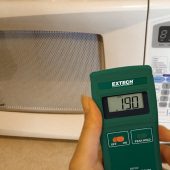An EMF meter detects and measures electromagnetic fields. It’s useful if you want to know if you are exposed to high EMF or if there’s EMF leakage from appliances like a microwave.
In this post, we go behind the scenes to find out exactly how EMF meters work. We also have some tips on how best to use an EMF meter.
What Does an EMF Meter Measure?
Many people these days are worried about EMF exposure. But it is virtually impossible to avoid electromagnetic fields, also referred to as electromagnetic radiation.
Wherever there is electricity, there is radiation. That’s because flowing electric current generates an electromagnetic field. So we are surrounded by radiation from power lines, electrical circuits, appliances and gadgets.
Even if you were to escape the modern world and live off-grid without any electricity, you’d still be exposed to radiation. The sun and even the earth itself are also sources of electromagnetic fields.
Experts say that most of the EMF around us is harmless. But if you still want to make sure you are not being exposed to too much radiation, an EMF meter can tell you the source of electromagnetic fields and how strong they are.
An EMF meter can be especially helpful if you have an implanted medical device such as a pacemaker or an ICD (implantable cardioverter-defibrillators). Prolonged exposure to powerful electromagnetic radiation can affect the safety and function of these devices.
With an EMF meter, you can measure how much radiation is coming from your router, bluetooth device or the cell tower near your home. EMF meters can also pick up radiation leakages from microwaves and other appliances.
EMF meters are often used in industrial and commercial applications for troubleshooting, equipment testing and personnel safety.
Some people also use EMF meters for ghost hunting. You may have seen one of those paranormal shows on TV. But there is no scientific evidence that you can detect ghosts using an EMF meter.
How Does An EMF Meter Work?
There is a lot of technical stuff behind the workings of an EMF meter. But here’s the short of it.
An EMF meter detects electromagnetic fields using specialised sensors that are sensitive to changes in the surrounding electromagnetic environment. The process involves converting the presence of electromagnetic waves into an electrical signal that the meter can measure and display.
Here’s a more detailed explanation of how this detection process works:
- Sensors: EMF meters are equipped with sensors, often based on principles like Hall Effect or coil induction. These sensors are designed to respond to the presence of electromagnetic fields.
- Interaction with electromagnetic fields: When the meter is brought close to a source of electromagnetic fields, such as an electronic device, an appliance or a power line, the electromagnetic waves emitted by that source interact with the sensor in the meter.
- Induced current: The electromagnetic waves induce a small electric current within the sensor. This current is proportional to the strength and frequency of the electromagnetic field.
- Amplification and conversion: The induced current is very weak, so it needs to be amplified to a level that can be measured accurately. The meter’s internal circuitry amplifies this weak signal and converts it into a measurable voltage or signal.
- Measurement and display: The amplified signal is then processed and displayed on the meter’s screen. This display usually provides information about the strength of the electromagnetic field in units like volt per meter (V/m), milligauss (mG) or microteslas (µT), depending on the specific model of the meter.
- Axis and direction detection: In the case of a three-axis EMF meter, the sensors are positioned along three different axes: X, Y, and Z. This allows the meter to detect electromagnetic fields coming from any direction without requiring the meter to be physically repositioned. Some advanced EMF meters will tell you which direction the radiation is coming from.
- Reading the measurements: You can then interpret the displayed measurement to understand the level of electromagnetic radiation present in the area. Most meters have a hold button that freezes the highest reading on the screen. Different meters might also have features to provide additional information, such as peak readings, average readings, and frequency analysis.
Types of EMF Meters
There are generally two types of EMF meters: single-axis and three-axis meters.
Single-axis meters are cheaper and are typically used for residential and hobbyist applications such as checking radiation from a microwave or looking for hidden cameras.
Single-axis EMF meters measure radiation along one axis. So to get an accurate reading of the strength of electromagnetic radiation, you need to rotate the meter to get readings in all three axes.
A three-axis EMF meter is more expensive but it’s easier to use and delivers more precise measurements. It measures radiation along three axes at the same time, so you don’t need to move the meter about to get an accurate measurement.
EMF meters can also be categorised based on the EMF frequency they measure.
- Low-Frequency EMF Meters: These are designed to measure electromagnetic fields produced by household appliances, power lines, and other low-frequency sources. They typically measure fields in the frequency range of 50 Hz to a few kHz. There are special low frequency EMF meters that measure extremely low frequency (ELF) radiation with a frequency of under 300 MHz.
- High-Frequency EMF Meters: These meters focus on measuring higher-frequency electromagnetic fields, such as those emitted by wireless devices like Wi-Fi routers, cell phones, and microwaves. They cover frequency ranges higher than a few kHz, extending into the MHz and GHz ranges.
- Radiofrequency (RF) Meters: RF meters specifically target radiofrequency electromagnetic fields, which are emitted by wireless communication devices like cell phones, radio towers, and Wi-Fi networks. They can help assess exposure to RF radiation.
Other Types of EMF Monitors
Magnetic Field Meters: These measure the strength of the magnetic component of an electromagnetic field. They are particularly useful for assessing exposure to magnetic fields produced by power lines, electrical wiring, and some appliances.
Electric Field Meters: Electric field meters measure the strength of the electric component of an electromagnetic field. They are helpful for assessing electric field exposure near sources like power lines and electrical equipment.
Personal EMF monitors: These wearable devices continuously measure and monitor the wearer’s exposure to electromagnetic fields. They provide real-time data and are often used by individuals concerned about their EMF exposure, such as technicians, power plant workers, telecommunication engineers and people with pacemakers.
Spectrum analyzers: While not typically referred to as EMF meters, spectrum analyzers are advanced devices used to analyse and visualise the electromagnetic spectrum. They can show the distribution of frequencies in an area, which is useful for identifying sources of EMF radiation.
Environmental EMF meters: These meters are designed to assess EMF levels in various environments, such as homes, offices, and outdoor spaces. They may have features like data logging, sound alerts, and different measurement modes.
It’s important to choose the right type of EMF meter based on your specific needs and the types of electromagnetic fields you’re concerned about. Some meters are more suitable for general assessments, while others are specialised for specific frequency ranges or sources of EMF radiation.
How to Use an EMF Meter?
The first step is to understand what kind of EMF meter you have. Different EMF meters have varying features and settings. Go through the user manual before using the EMF meter.
For instance, with some EMF meters you only need to turn it on and hold it close to the source of radiation.
Other EMF meters measure electric fields, magnetic fields and radio frequency (RF) separately. You need to switch to the right mode depending on what you are measuring.
You would use the electric or magnetic field mode to measure radiation from appliances, power lines, wiring, lights and wall outlets. Switch to the RF mode to measure radiation from your smartphone, a cell tower, microwave oven or WiFi router.
If your EMF meter has a normal and weighted mode, use the normal mode to measure lower frequency radiation such as wiring and the weighted mode to measure higher frequency (above 60Hz) radiation from appliances.
Most EMF meters have a button that holds the maximum reading and a unit button that switches between different measurement units.
Your model may also have advanced features such as threshold alarm to alert you when the reading goes over a set point and a memory or recall button to bring up past readings.
Here’s a great video with more tips on how to use an EMF meter.


